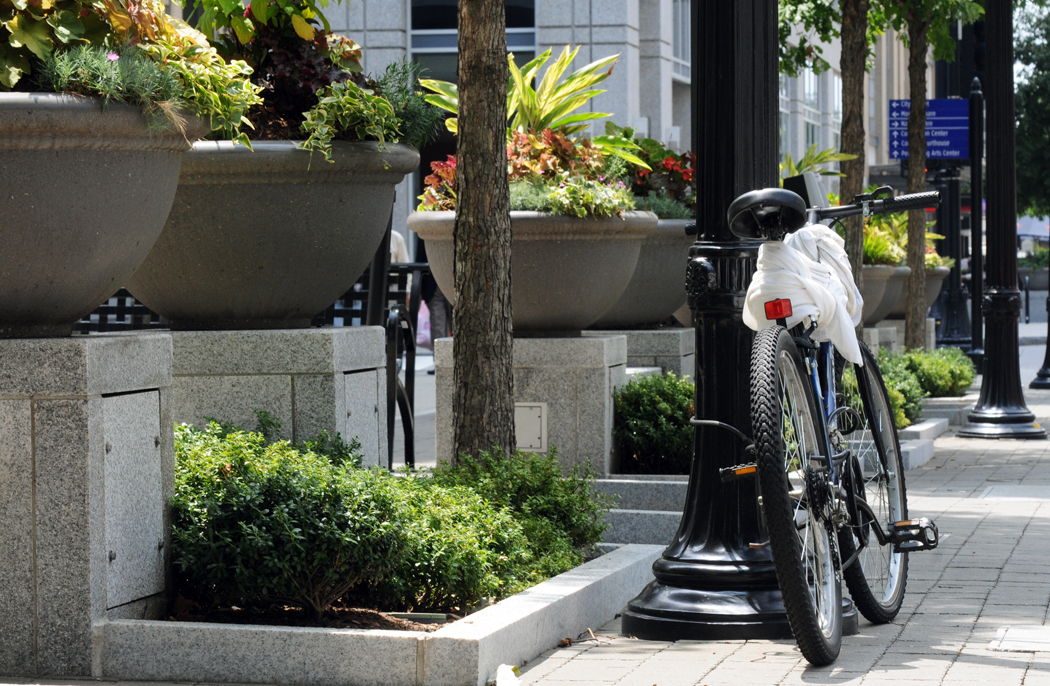The Bicycle and Pedestrian Advisory Commission wants to make Raleigh a place where riding your bike is the norm. And if they have their way, that will be the case in less than 10 years.
BPAC Chair Alan Wiggs said one of the commission’s biggest accomplishments during the past year was implementing a training course on bicycle law and safety for Raleigh police officers. Cyclists are bound by the same rules of the road as drivers. The online training is simply a review of those laws, which sometimes go unenforced.
“It seems simple,” said Raleigh Transportation Manager Eric Lamb, “but it’s something hardly anyone has done nationally.”
Lamb said it is part of a conscious effort to create a mutual respect between drivers and cyclists. When cyclists don’t follow the rules, it creates a lot of resentment in drivers, which isn’t safe for either.
The commission has also been working on public outreach and education to get people out of their cars and onto their bikes or on their feet.
While it seems like it should work in the opposite way, the more cyclists there are on the road, the safer it is, Wiggs said. Drivers eventually get used to sharing the road, causing less anxiety.
That mindset is why the city has slowly begun to include more projects that are geared toward cyclists and pedestrians.
Lamb said it is a piecemeal approach that will eventually come together, similar to Raleigh’s Greenway system. The installation of bike lanes or sharrows — street markings that alert drivers to share the road with cyclists — becomes part of the plan when a road project is underway.
“As these improvements come together over time, it’s making implementation a lot easier,” Lamb said.
Some upcoming projects for 2012:
One project open for public comment is Hillsborough Street between Oberlin and Morgan streets. Planning staff presented eight different options for the stretch, some more feasible than others. Cross sections include a mix of bike lanes and sharrows.

Two potential options for Hillsborough Street bike lanes.
Lamb said comments from the neighborhood indicate a preference for on-street parking, which increases the need for pedestrian access.
“We’re trying to strike that harmonious ground in terms of what the neighborhood wants and what the space would allow,” he said.
BPAC has also been reviewing the 2030 Comprehensive Plan and the Unified Development Ordinance, which includes codes and regulations to further the city’s goal of becoming bike friendly.
“If you want people to ride bikes you have to have racks,” said Wiggs, who believes that one day Raleigh will have bike lanes throughout the city. “As long as you get people over the fact that we have some pretty brutal hills, we can be a world class bike city.”
Other projects on the way for the next year:

"Sharrows" remind motorists to share the road with bicyclists.
- Faircloth St, Hillsborough Street to Wade Avenue (bike lanes)
- Clark Avenue, Faircloth Street to St. Mary’s Street (combination of bike lanes and sharrows)
- Oberlin Road, Hillsborough Street to Glenwood Avenue (sharrows)
- Hillsborough Street, Oberlin Road to Morgan Street (bike facility undecided)
- Brooks Avenue, Wade Avenue to Hillsborough Street (combination of bike lanes and sharrows)
- Pullen Road, Watauga Club to Western Boulevard (sharrows)
Walk This Way
Sidewalks also got some extra attention in 2011. This year, the City Council voted to change the city code that made the maintaining or building of sidewalks the responsibility of the property owner.
Previously, if a sidewalk needed repair, it was up to the homeowner to foot the bill. This resulted in a financial hardship for which many residents don’t see a direct benefit. It was argued that because sidewalks are used by the public, they should be publicly maintained.
As a result, broken sidewalks often went unfixed and areas where sidewalks could be built, they weren’t.
 The change in the code now makes the building and maintaining of sidewalks the city’s responsibility. Since the change, Lamb said that the Public Works Department has noticed an increase in requests for sidewalk repair.
The change in the code now makes the building and maintaining of sidewalks the city’s responsibility. Since the change, Lamb said that the Public Works Department has noticed an increase in requests for sidewalk repair.
Because of this change, the city has allocated $11.75 million to be put toward sidewalks, all approved with the passing of the $40 million transportation bond passed in October.
Of the sidewalk funds in the bond, nearly $5 million is for city-initiated sidewalk creation, $3 million is for resident petitioned sidewalks and $4 million is allocated for sidewalk repair.
Lamb said that the city is moving toward embracing a “complete streets” philosophy, which includes sidewalks on all roads, including high-volume ones like Creedmoor Road.
The commission is putting the final touches on a pedestrian plan, which will be available for public comment the beginning of January. The plan highlights hot spots in Raleigh that need pedestrian improvements, especially areas that are considered unsafe.
“For the city, the pedestrian plan it gives direction on what areas need focus,” Wiggs said.
During that time, residents can petition for sidewalks or sidewalk maintenance in their neighborhoods.
